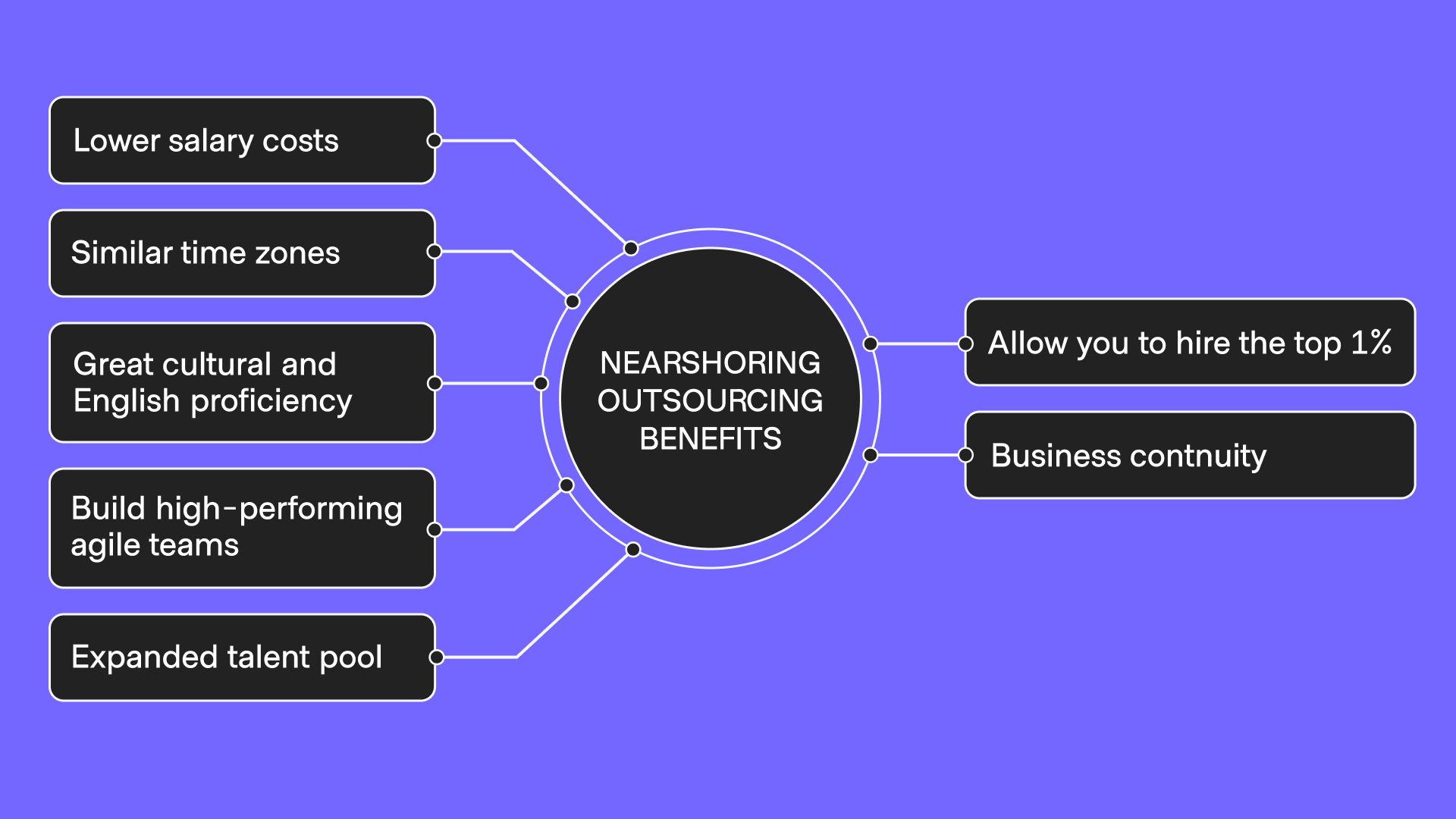Dutch companies face a recurring constraint: local talent is expensive and scarce, offshore delivery creates coordination friction, and growth demands solutions that don't compromise quality or control.
Nearshore outsourcing (embedding teams in nearby countries) has emerged as a viable third path. Not a cost-cutting exercise, but a deliberate approach to building distributed capability.
We operate this model between the Netherlands and Serbia. Our clients include Royal Terberg Group, where we built a Microsoft Dynamics support function in 30 days, and Firsty, where we've supported technical hiring. This article examines how the model works and why it's gaining traction.
Defining Nearshore Outsourcing
Nearshoring shifts specific functions, typically IT, support, or development, to nearby countries with shared working hours and cultural proximity. The key constraint: maintaining operational cohesion while accessing different cost structures.
For Western European companies, Serbia represents an optimal nearshore location. Same time zone as Amsterdam or Berlin. Strong technical education infrastructure. English fluency as standard. Wage arbitrage without the coordination overhead of traditional offshore models.
We focus on roles requiring domain expertise and retention: ERP implementation, Microsoft stack development, frontend/backend engineering, and process-heavy functions like compliance and financial operations.
The Spectrum of Outsourcing Models
Onshore: Maximum control, premium cost structure Nearshore: Balanced control and cost, shared operational hours Offshore: Cost optimization, coordination complexity
Most companies default to onshore for core functions and offshore for peripheral tasks. This creates a missing middle, functions that need quality and continuity but don't justify local premium pricing.
Our approach: build core decision-making capability locally, embed execution capability nearshore, maintain global recruitment access as needed.
Nearshore Team Extension vs. Project Outsourcing Traditional outsourcing delegates entire projects or functions. You hand over requirements, receive deliverables, manage the interface.
Team extension embeds external talent into your existing operations. Nearshore hires join your standups, work in your systems, follow your processes. The difference: you maintain direct control over daily work while outsourcing employment complexity.
This model works when you need specific skills integrated into existing workflows, not when you need entire functions managed externally.
Talent Shortage in the Netherlands
- In the Netherlands, 12% of companies sought ICT specialists, and 70% of hiring companies reported difficulty finding suitable candidates. This shortage is expected to continue for at least another 10 years.
- Expected software revenue growth: €1.5B (2024–2028), a 16% increase.
- In 2024, access to talent (56%) and scalability (51%) overtook cost as main outsourcing drivers.
In 2023, 39% of large European IT spending organizations planned to maintain outsourcing levels, 31% planned to increase, and only 15% planned to reduce. Source

Economic Arbitrage with Quality Premium
30-60% cost reduction compared to Western European hiring, but we pay above local market rates. This creates a quality filter, we attract experienced professionals who value stability over maximum local compensation.
Specialized Talent Density
Serbia has developed concentrated expertise in enterprise software, particularly Microsoft and SAP ecosystems. We maintain active pipelines of Dynamics F&O consultants but also Python engineers, .net and node js profiles that are scarce and expensive in Western Europe.
Operational Continuity
CET timezone alignment eliminates asynchronous handoff delays. Real-time collaboration, shared working hours, immediate decision-making capability.
Communication and Process Maturity
Our screening process prioritizes communication skills and enterprise process experience. Many candidates have previous nearshore or Western client experience. English fluency and business communication skills are baseline requirements, not differentiators.
Senior-Level Access
Your Dutch hiring budget typically attracts mid-level local talent. The same budget in Serbia accesses senior profiles with 5-10 years of relevant experience. Not junior developers, consultants and technical leads.
Risk Distribution
Geographic distribution reduces single-point-of-failure risk. When local teams face capacity constraints or key person dependencies, nearshore capability provides operational continuity.
Implementation Challenges and Solutions
Employment Law and Compliance
Serbian employment requires local entity setup, payroll systems, and GDPR compliance frameworks. We handle employment, contracts, and regulatory requirements. You get the talent without the legal infrastructure.
Technical Screening and Capability Matching
Generic recruitment focuses on keyword matching. We maintain domain expertise in our screening process, former engineers and ERP consultants who understand capability depth, not just CV formatting.
Cultural and Process Integration
Serbian business culture emphasizes detailed documentation and structured communication. We provide cultural briefings and process alignment during onboarding to match your operational style.
Infrastructure and Security
We provide guidance on secure remote access, shared development environments, and communication stack integration. Optional team lead placement for complex integrations.
Strategic Timing
Remote work normalization has reduced location-based hiring bias. Talent shortages in core European markets have increased hiring timelines and compensation expectations. Budget constraints have created pressure to optimize team composition.
Serbia's technical education system has matured significantly. High English proficiency, strong STEM university programs, and lower brain drain compared to neighboring countries. The result: a stable, skilled workforce without the wage inflation seen in Poland or Romania.
Companies that build intelligent geographic distribution, local strategy and decision-making, nearshore execution, global talent access, create sustainable competitive advantages in both cost structure and capability access.
Operational Framework
Nearshoring works best as part of a broader team architecture strategy. Core functions remain local. Execution-heavy, skill-specific roles move nearshore. Opportunistic hiring happens globally.
We help companies design this distribution based on their specific constraints: regulatory requirements, cultural fit, skill availability, and cost optimization priorities.
The successful model isn't about finding the cheapest resources. It's about building the most effective team structure given your constraints and objectives.
Implementation Approach
Start with a specific capability gap or capacity constraint. Build one nearshore position successfully. Expand based on results and learning.
We provide end-to-end support: talent identification, screening, onboarding, ongoing management, and scaling guidance. Founder-led engagement, GDPR compliance, and flexible scaling without long-term commitments.
The goal isn't to replace local hiring but to create a more intelligent approach to team building, one that optimizes for quality, cost, and control simultaneously.

